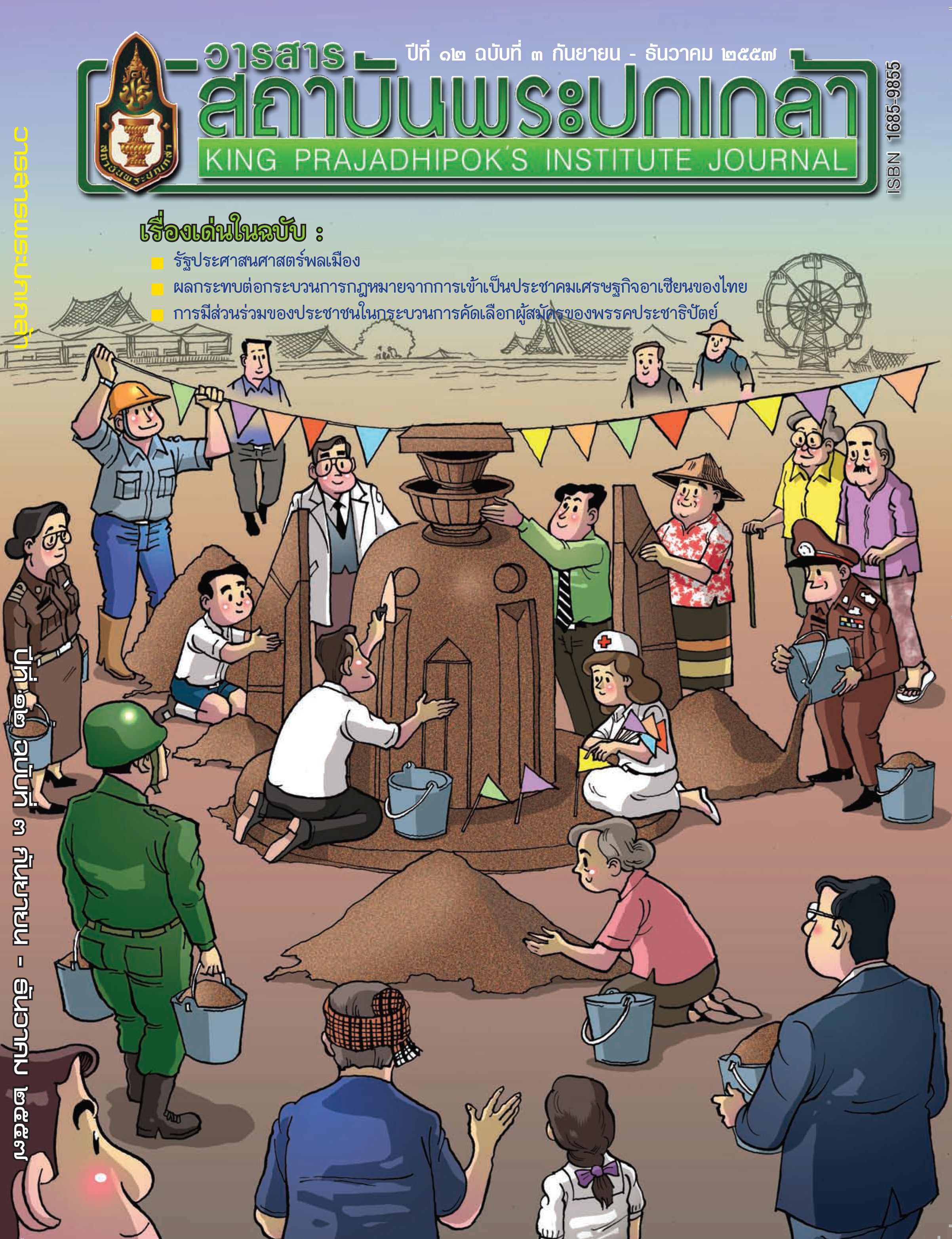สันติวิธี? : กำนันสไตล์
Main Article Content
บทคัดย่อ
นับตั้งแต่ปลายเดือนตุลาคม ๒๕๕๖ ที่นายสุเทพ เทือกสุบรรณ เลขาธิการคณะกรรมการประชาชนเพื่อเปลี่ยนแปลงประเทศไทยให้เป็นประชาธิปไตยที่สมบูรณ์อันมีพระมหากษัตริย์ทรงเป็นประมุข (กปปส.) และประชาชนแนวร่วมได้เริ่มต้นชุมนุมประท้วงสภาผู้แทนราษฎรที่ได้ลงมติให้ร่างพระราชบัญญัตินิรโทษกรรมแก่ผู้ซึ่งกระทำความผิดเนื่องจากการชุมนุมทางการเมือง การแสดงออกทางการเมืองของประชาชน พ.ศ.... ผ่านการพิจารณาในวาระที่สองและสาม ส่งผลให้ร่างพระราชบัญญัติดังกล่าวต้องตกไป จนกระทั่งได้พัฒนาประเด็นข้อเรียกร้องมาเป็นขับไล่รัฐบาล โดยเสนอให้มีการปฏิรูปก่อนการเลือกตั้งด้วยการมีนายกรัฐมนตรีคนกลาง การชุมนุมของกลุ่ม กปปส. จบลงด้วยเหตุการณ์การประกาศกฎอัยการศึกและตามมาด้วยการรัฐประหารในเดือนพฤษภาคม ๒๕๕๗
อย่างไรก็ตาม การชุมนุมเรียกร้องของกลุ่ม กปปส. เพื่อให้บรรลุตามเป้าหมาย เกิดคำถามจากสังคมว่าเป็นการเรียกร้องอย่างสันติวิธีหรือเน้นไปที่การใช้ความรุนแรง บทความนี้จะมุ่งตอบคำถามดังกล่าวในประการแรก โดยเชื่อมโยงกับแนวคิดการปฏิบัติการไร้ความรุนแรง ของศาสตราจารย์ ยีน ชาร์ป (Gene Sharp) ผู้ซึ่งได้คิดค้น รวบรวมปฏิบัติการไร้ความรุนแรงไว้ในการเอาชนะรัฐบาลเผด็จการด้วยวิธีการต่างๆ แน่นอนว่าปฏิบัติการไร้ความรุนแรงดังกล่าว มีความแตกต่างอย่างยิ่งกับสันติวิธีของมหาตมะ คานธี มหาบุรุษชาวอินเดียที่ต่อต้านจักรวรรดินิยม อังกฤษในการปกครองอาณานิคมอินเดีย กล่าวคือมหาตมะ คานธี เน้นที่ ๑ . ความรักและมีเมตตาต่อผู้ที่เกลียดเรา ผลก็คือคนอังกฤษจำนวนมากไม่เกลียดชัง เคียดแค้นคานธี ๒. การต่อสู้เรียกร้องอย่างสันตินั้น ต้องไม่กลัวว่าจะต้องสูญเสียอวัยวะ ทรัพย์สมบัติ หรือแม้กระทั่งชีวิต ๓. การต่อสู้เรียกร้องนั้นต้องไม่ใช้กำลังกับฝ่ายตรงข้าม อดทน คานธียอมพลีชีพของตนเองเพื่อให้บรรลุสิ่งที่ตนพึงประสงค์
ในขณะที่แนวทางของยีน ชาร์ป นั้นเน้นการเรียกร้องอย่างสันติเพื่อเอาชนะฝ่ายตรงข้าม เพราะเห็นว่าถ้าใช้ความรุนแรงในการเรียกร้อง ก็จะถูกปราบปราม ตอบโต้กลับอย่างรุนแรง แต่ถ้าไม่ใช้ความรุนแรงก็จะนำไปสู่ความเห็นอกเห็นใจได้แนวร่วม และยิ่งรัฐบาลเน้นปราบปรามผู้มาเรียกร้องที่ไม่ใช้อาวุธ ก็จะเกิดสิ่งที่เรียกว่า “ยิวยิตสูทางการเมือง” รัฐบาลก็จะไม่มีความชอบธรรมในการบริหารประเทศอีกต่อไป โดยการเอาชนะฝ่ายตรงข้ามไม่จำเป็นต้องมีความรักในเพื่อนมนุษย์แต่อย่างใด ในประการที่สอง บทความนี้มุ่งศึกษาว่าการเรียกร้องเพื่อให้บรรลุตามเป้าหมายของกลุ่ม กปปส.นั้น ใช้แนวทาง และยุทธิวิธีอย่างไรบ้างตามแนวทางปฏิบัติการไร้ความรุนแรงของยีน ชาร์ป ซึ่งแบ่งได้กว้างๆ เป็น ๓ วิธีคือ ๑. การประท้วงและโน้มน้าว ๒. การไม่ให้ความร่วมมือและ ๓. การขัดขวาง
Article Details
@ 2020 King Prajadhipok's Institute The Government Complex Commemorating All Right Reserved.
เอกสารอ้างอิง
ชาร์ป, ยีน. ๒๕๒๙. อำนาจและยุทธวิธีไร้ความรุนแรง. ชัยวัฒน์ สถาอานันท์ และคมสันต์ หุตะแพทย์, ผู้แปล. กรุงเทพฯ : บริษัทเคล็ดไทย จำกัด.
ธนชัย แสงจันทร์. ๗ กุมภาพันธ์ ๒๕๕๗. เนชั่นสุดสัปดาห์. ปีที่ ๒๒ ฉบับที่ ๑๑๓๒.
เนชั่นสุดสัปดาห์. ๒๑ กุมภาพันธ์ ๒๕๕๗. ปีที่ ๒๒ ฉบับที่ ๑๑๓๔.
เนชั่นสุดสัปดาห์. ๒๘ มีนาคม ๒๕๕๗. ปีที่ ๒๒ ฉบับที่ ๑๑๓๙.
เนชั่นออนไลน์. ๒๕ กุมภาพันธ์ ๒๕๕๗ สืบค้น ๓๐, มีนาคม ๒๕๕๗, จาก http://www.nationchannel.com
แนวหน้าออนไลน์. ๑๙ มีนาคม ๒๕๕๗ สืบค้น ๓๐, มีนาคม ๒๕๕๗,จาก http://www.naewna.com
พระไพศาล วิสาโล. ๒๕๕๓. สร้างสันติด้วยมือเรา. พิมพ์ครั้งที่ ๒. กรุงเทพฯ: ศูนย์ศึกษาและพัฒนาสันติวิธี มหาวิทยาลัยมหิดล.
มติชนรายสัปดาห์. ๗-๑๓ กุมภาพันธ์ ๒๕๕๗. ปีที่ ๓๔ ฉบับที่ ๑๗๔๗.
มติชนรายสัปดาห์. ๑๔-๒๐ กุมภาพันธ์๒๕๕๗. ปีที่ ๓๔ ฉบับที่ ๑๗๔๘.
มติชนรายสัปดาห์. ๒๘ กุมภาพันธ์ – ๖ มีนาคม ๒๕๕๗. ปีที่ ๓๔ ฉบับที่ ๑๗๕๐.
มติชนรายสัปดาห์. ๑๔ - ๒๐ มีนาคม ๒๕๕๗. ปีที่ ๓๔ ฉบับที่ ๑๗๕๒.
ราษฎร์ บำรุงรัฐ. เนชั่นสุดสัปดาห์ ๒๑ กุมภาพันธ์ ๒๕๕๗. ปีที่ ๒๒ ฉบับที่ ๑๑๓๔.


